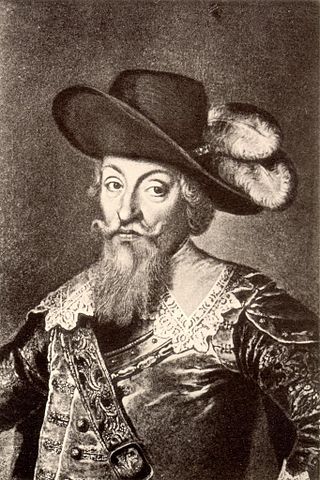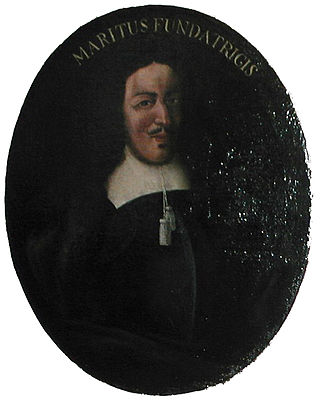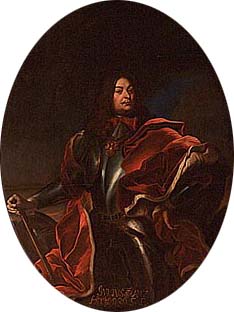Life
Francis Charles was a son of the Duke Francis II of Saxe-Lauenburg (1547–1619) from his second marriage to Maria of Brunswick-Lüneburg.
In 1619, Francis Charles and his brothers confirmed in an inheritance contract that their elder half-brother Augustus would inherit all of Saxe-Lauenburg. Francis Charles went into military service, and after serving in various armies, he eventually joined the Protestant army of Count Ernst von Mansfeld. With this army, he fought in Bohemia against Emperor Ferdinand II. Three of his brothers served in the imperial army opposing him.
In 1623, Francis Charles' elder brother Julius Henry came to a reconciliation with the Emperor. At a meeting of Protestant Princes in Lauenburg upon Elbe in 1625, it was decided to put Lower Saxony under the protection of King Christian IV of Denmark against the Emperor and his Catholic League. Francis Charles recruited a new regiment for the Danish King and quartered it in his brother's neutral Saxe-Lauenburg, where his troops took a hostile stance. After Christian IV was defeated, Francis Charles asked Wallenstein to help him seek another reconciliation with the Emperor.
On 19 September 1628 Francis Charles married Agnes of Brandenburg, widow of the Duke Philip Julius of Pomerania-Wolgast. Again with the help of Wallenstein, his brother Francis Julius achieved, that his wife was allowed keep her jointure, the district of Barth. After King Gustavus II Adolphus of Sweden had landed in Pomerania in 1630, Francis Charles entered his service as a colonel. Francis Charles was captured at the residence of his brother Augustus in Ratzeburg by the imperial general Pappenheim, but was soon back in Swedish service as a colonel. After the death of Gustavus Adolphus, Francis Charles switched sides and joined the army of the Electorate of Saxony. This allowed him to reconcile with the Emperor once again.
In 1637, Francis Charles converted to Catholicism and entered the imperial service as a major general. After the death of his first wife, and after imperial mediation Francis Charles married on 27 August 1639 in Sopron Catherine of Brandenburg, the very rich widow of the Transylvanian prince Gábor Bethlen. His second wife sold all her Hungarian possessions and moved with her husband to Germany, where she died in 1649. Francis Charles remarried in 1651 Countess Elisabeth Christine of Meggau, widow of the Baron Adolf Christoph of Teuff. After leaving the military service he toured Italy. He died in Saxe-Lauenburgian Neuhaus and, despite his three marriages, he left only children born out of wedlock.

The Battle of Lützen, fought on 6 November 1632, is considered one of the most important battles of the Thirty Years' War. Led by the Swedish king Gustavus Adolphus, an Allied army primarily composed of troops from Sweden, Saxony, and Hesse-Kassel, narrowly defeated an Imperial force under Albrecht von Wallenstein. Both sides suffered heavy casualties, with Gustavus himself among the dead.

Ottavio Piccolomini, 1st Duke of Amalfi was an Italian nobleman whose military career included service as a Spanish general and then as a field marshal of the Holy Roman Empire.

The sack of Magdeburg, also called Magdeburg's Wedding or Magdeburg's Sacrifice, was the destruction of the Protestant city of Magdeburg on 20 May 1631 by the Imperial Army and the forces of the Catholic League, resulting in the deaths of around 20,000, including both defenders and non-combatants. The event is considered the worst massacre of the Thirty Years' War. Magdeburg, then one of the largest cities in Germany, having well over 25,000 inhabitants in 1630, did not recover its importance until well into the 18th century.

Amt Neuhaus is a municipality in the District of Lüneburg, in Lower Saxony, Germany. Amt means "municipal office" in German. The original "municipal office of Neuhaus" existed since at least the 17th century until 1885, consecutively as part of Saxe-Lauenburg, Electorate of Hanover (1689-1810), Kingdom of Hanover (1814-1866), and the Prussian Province of Hanover (1866-1885).

John George I was Elector of Saxony from 1611 to 1656. He led Saxony through the Thirty Years' War, which dominated his 45-year reign.

The Peace of Prague, signed on 30 May 1635, ended Saxony's participation in the Thirty Years War. Other German princes subsequently joined the treaty and although the Thirty Years War continued, it is generally agreed Prague ended it as a war of religion within the Holy Roman Empire. Thereafter, the conflict was largely driven by foreign powers, including Spain, Sweden, and France.

The Duchy of Saxe-Lauenburg, was a reichsfrei duchy that existed from 1296 to 1803 and again from 1814 to 1876 in the extreme southeast region of what is now Schleswig-Holstein. Its territorial center was in the modern district of Herzogtum Lauenburg and originally its eponymous capital was Lauenburg upon Elbe, though the capital moved to Ratzeburg in 1619.

George William was the first Welf Duke of Lauenburg after its occupation in 1689. From 1648 to 1665, he was the ruler of the Principality of Calenberg as an appanage from his eldest brother, Christian Louis, Prince of Luneburg. When he inherited Luneburg on the latter's death in 1665, he gave Calenberg to his younger brother, John Frederick.

Johann or Hans Georg von Arnim-Boitzenburg was a German Field Marshal. At different times during the Thirty Years' War, he was a Field Marshal for the Holy Roman Empire and its opponent the Electorate of Saxony. He also pursued various diplomatic tasks.

Henry V of Brunswick-Wolfenbüttel, called the Younger,, a member of the House of Welf, was Duke of Brunswick-Lüneburg and ruling Prince of Brunswick-Wolfenbüttel from 1514 until his death. The last Catholic of the Welf princes, he was known for the large number of wars in which he was involved and for the long-standing affair with his mistress Eva von Trott.

The Treaty of Fontainebleau was signed on 30 May 1631 during the Thirty Years' War, at the Palace of Fontainebleau. It was a pact of mutual assistance between Maximilian I, Elector of Bavaria, and France, for a period of eight years.

Francis II of Saxe-Lauenburg, was the third son of Francis I of Saxe-Lauenburg and Sybille of Saxe-Freiberg, daughter of Duke Henry IV the Pious of Saxony. From 1581 on he ruled Saxe-Lauenburg as duke.

Augustus of Saxe-Lauenburg was Duke of Saxe-Lauenburg between 1619 and 1656. He was a son of Duke Francis II and his first wife Margaret of Pomerania-Wolgast, daughter of Philip I, Duke of Pomerania-Wolgast. Since Augustus survived all his sons he was succeeded by his half-brother Julius Henry.

Julius Henry was duke of Saxe-Lauenburg between 1656 and 1665. Before ascending to the throne he served as Field Marshal in the imperial army.

Julius Francis was duke of Saxe-Lauenburg between 1666 and 1689. He was a son of Duke Julius Henry and his third wife Anna Magdalena of Lobkowicz (1606–1668), daughter of Baron William the Younger Popel of Lobkowicz. He was officially known as Julius Franz von Sachsen, Engern und Westfalen.

William Louis of Nassau-Saarbrücken, was a Count of Saarbrücken.

Maria of Brunswick-Wolfenbüttel was a princess of Brunswick-Wolfenbüttel by birth and by marriage Duchess of Saxe-Lauenburg.

Agnes of Brandenburg was a Princess of Brandenburg by birth and by marriage successively Duchess of Pomerania and of Saxe-Lauenburg.
Duke Francis Julius of Sachsen-Lauenburg was a prince of Saxe-Lauenburg.

Hedwig of Brandenburg, a member of the Hohenzollern dynasty, was Duchess of Brunswick-Lüneburg and Princess of Brunswick-Wolfenbüttel from 1568 to 1589, by her marriage with the Welf duke Julius.


















